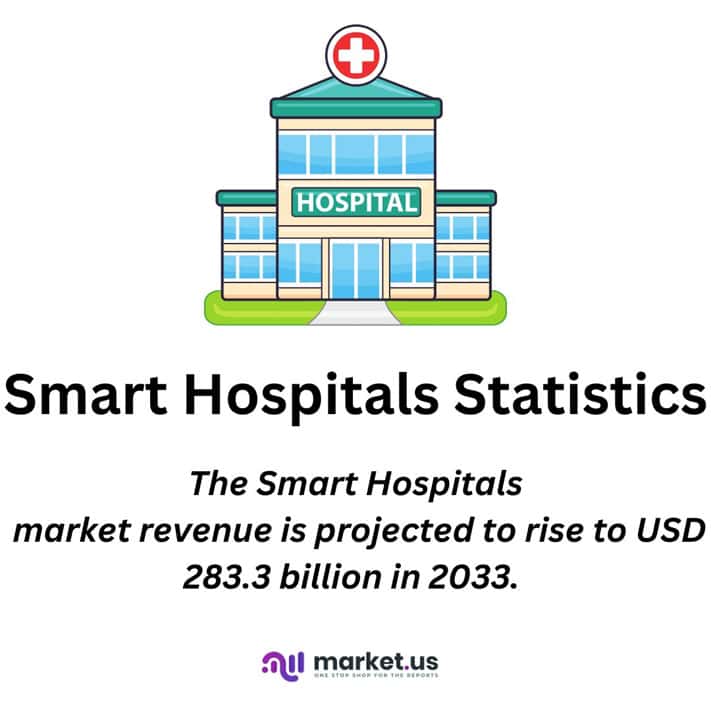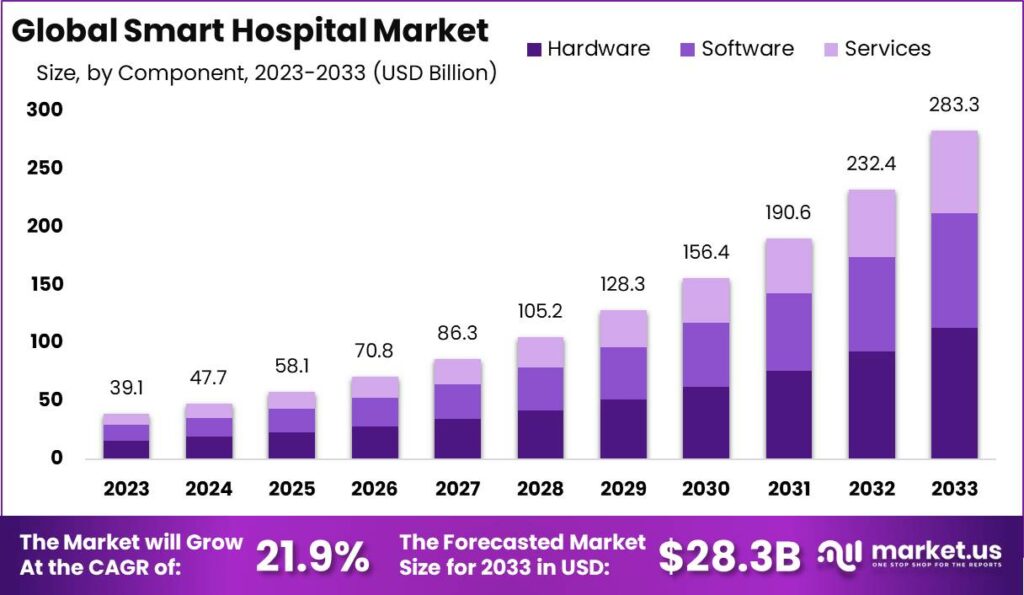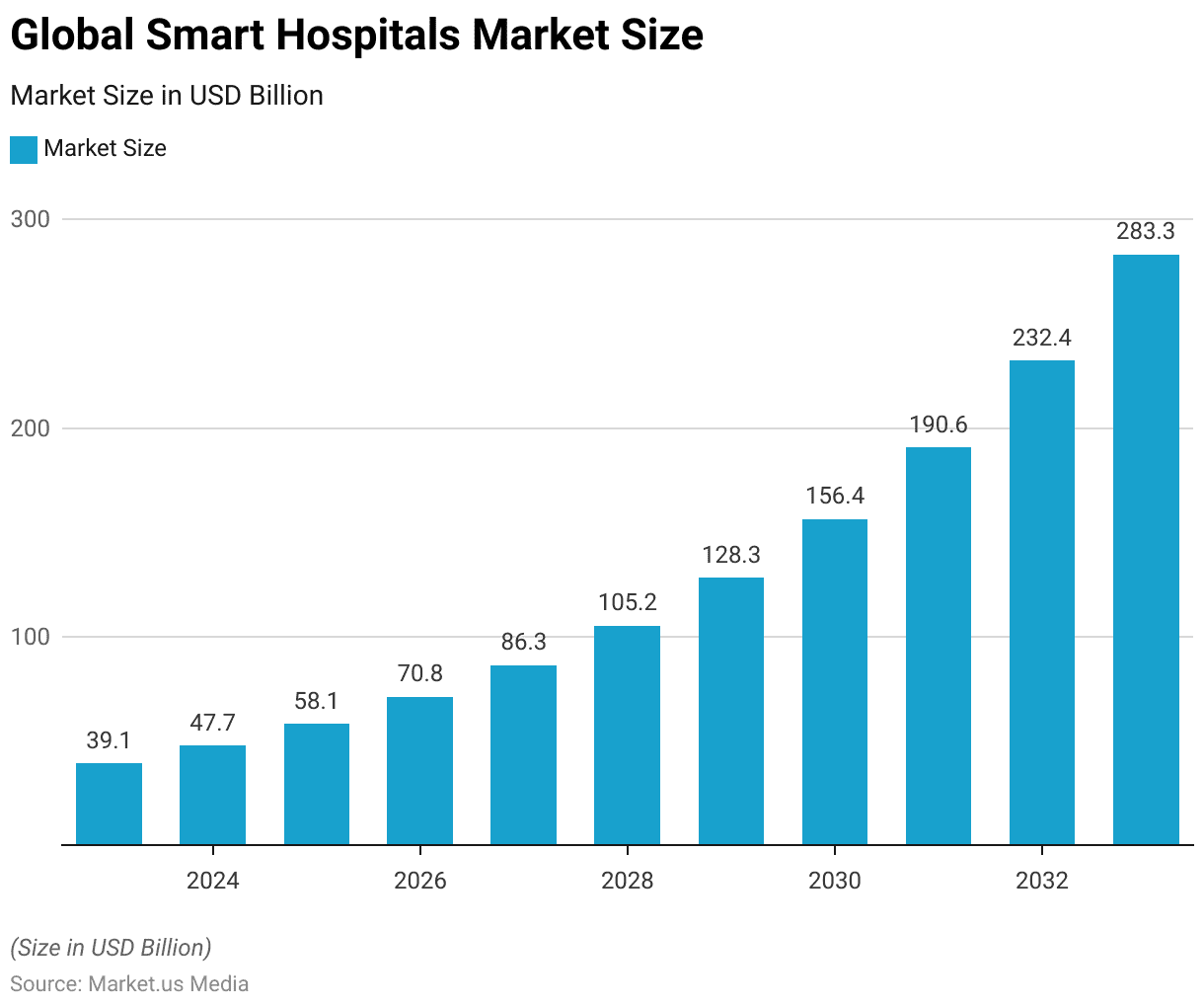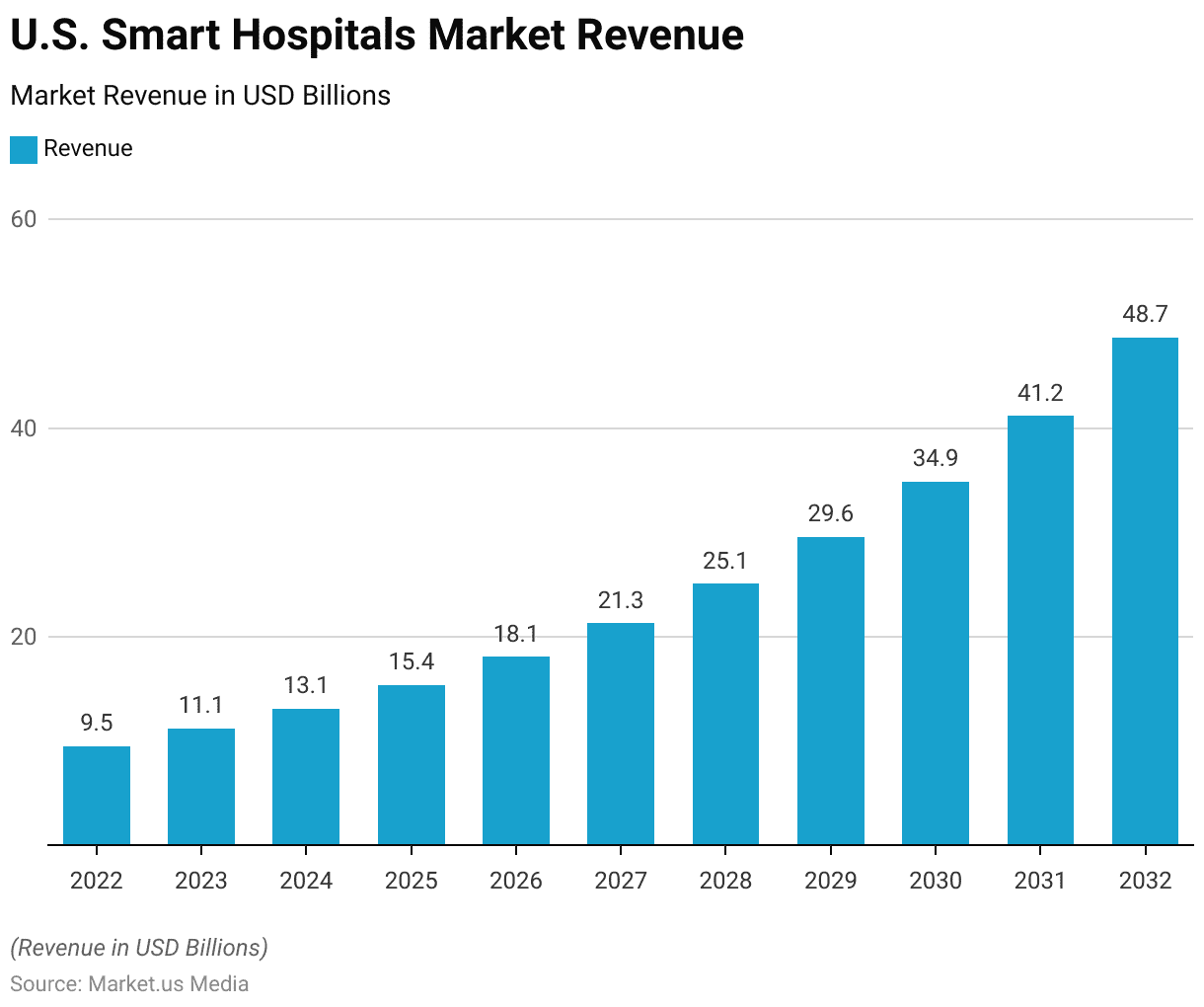Table of Contents
- Introduction
- Editor’s Choice
- Global Smart Hospitals Market Statistics
- Smart Hospitals Market Statistics – By Technology
- Smart Hospitals Market Statistics – By Connectivity
- Smart Hospitals Market Statistics – By Applications
- Regional Analysis of Smart Hospitals Statistics
- Emerging Technologies Used in Smart Hospital Statistics
- Recent Developments
- Conclusion
- FAQs
Introduction
Smart Hospitals Statistics: Smart hospitals are modern healthcare facilities that harness advanced technologies and data-driven approaches to enhance patient care and operational efficiency.
They utilize digital health records, connected medical devices, remote patient monitoring, and automation to streamline processes and improve healthcare delivery.
These hospitals also prioritize patient engagement through mobile apps and portals. While predictive analytics aids in resource allocation and disease outbreak predictions. Security and privacy are crucial considerations, in ensuring the confidentiality of medical records.
Ultimately, smart hospitals aim to optimize workflows, reduce wait times, and provide an improved healthcare experience by integrating various innovative technologies.

Editor’s Choice
- At a CAGR of 21.9%, the global smart hospital market is expected to rise from USD 39.1 billion to USD 283.3 billion in 2033.
- Hardware components like IoT and medical devices lead the market with over 40% market share.
- The technology of IoT dominates the market with a 35% market share.
- Wireless connectivity is majorly used taking up 60% of the market.
- North America is the leader in the smart hospital market with about 46% share.
- The Medical Connected Imaging Segment used in smart hospitals is the widely used tool with about 25% of the market share.
- Benefits of smart hospitals include improved patient care, faster diagnosis, and treatment, streamlined work, etc.
- Some of the challenges the setting up a smart hospital include data security and privacy issues, regulatory compliance, staff training and acceptance, etc.
(Source: Market.us)

Global Smart Hospitals Market Statistics
- The Smart Hospital Market will reach USD 283.3 billion by 2033, at a CAGR of 21.9%. In 2023, the total was USD 39.1 billion.
- In 2023, the global smart hospital market is valued at $39.1 billion. This value is set to rise notably in 2024, reaching $47.7 billion. By 2025, the market is forecasted to expand further, reaching $58.1 billion.
- The growth momentum continues in 2026, with the market size increasing to $70.8 billion. In 2027, it is expected to climb to $86.3 billion, indicating a strong growth trend.
- The subsequent year, 2028, is projected to witness a substantial market size of $105.2 billion. Moving forward to 2029, the smart hospital market is estimated to be valued at $128.3 billion, and by 2030, it is anticipated to reach $156.4 billion.
- The upward trajectory persists in 2031, with the market expected to reach $190.6 billion. In 2032, the market size is forecasted to reach $232.4 billion, and finally, in 2033, it is estimated to stand at $283.3 billion.
- These figures highlight a consistent and significant upward movement in the global smart hospital market, driven by the growing demand for healthcare technology and digital solutions.
(Source: Market.us)

Smart Hospitals Market Overview- By Components Statistics
- The Smart Hospital market is divided into hardware components, software components, and Services.
- The portable devices had a market value worth USD 60.44 billion in 2022 and are expected to reach USD 120.8 billion by 2030 at a CAGR of 9.04%.
- IoT sensors saw a market value of USD 11.1 billion in 2022. It will reach USD 29.6 billion by 2026 with a CAGR of 33.78%.
- Services, a segment of components used in smart hospitals. It is projected to record a 22.5% CAGR and reach USD 137.6 Billion by 2030.
(Source: Market.us)
Take advantage of our unbeatable offer - buy now!

Smart Hospitals Market Statistics – By Technology
IoT Technology
- The global market for healthcare Internet of Things (IoT) security is expected to reach USD 36.269 billion by 2032. This growth reflects a significant annual growth rate (CAGR) of 36%, starting from its 2022 valuation of USD 1.675 billion.
- IoT technology can be utilized for the care of both pediatric and elderly patients, as well as the continuous monitoring of chronic diseases. IoT-based medical devices, when worn or attached to a patient’s body, capture detailed health information.
Cloud computing
- The worldwide Healthcare Cloud Computing Market will substantially expand. It is expected to reach USD 201.1 billion by 2032. Marking an increase from its 2022 valuation of USD 41.4 billion. This growth is attributed to a robust annual growth rate (CAGR) of 17.6% during the forecast period from 2023 to 2032.
(Source: Market.us)
Wearable Technology and Non-Wearable Technology
- The worldwide market for Smart Wearable and Non-Wearable Devices is poised for significant expansion. It projects to reach an estimated worth of approximately USD 105.8 Billion by the year 2032.
- This marks a considerable upswing from its 2022 valuation of USD 29.0 Billion. Underscoring a robust yearly growth rate (CAGR) of 14.2% throughout the forecast period that extends from 2023 to 2032.
(Source: Market.us)
Radio Frequency Technology
- This technology had a market value of USD 15.8 billion in 2023 and is growing at a CAGR of 11.1%. It is forecasted to reach USD 40.9 billion by 2032.

Smart Hospitals Market Statistics – By Connectivity
- In 2023, the Smart Hospital market witnessed a significant shift in market share among its different connectivity segments. The Wireless Segment emerged as the dominant player, securing an impressive market share of over 60%. This highlights the industry’s preference for wireless connectivity within smart hospital settings, marking a notable trend in the market.
- The global Wireless Health Market reached a valuation of USD 160.33 billion. It is now on a robust growth trajectory. With an annual growth rate of 23% anticipated throughout the forecast period spanning from 2023 to 2031.
- As wireless technology continues to progress, providing better reliability and security. The Wired Segment is likely to see a gradual reduction in its market share. This suggests a changing trend in favor of wireless solutions.
(Source: Market.us)

Smart Hospitals Market Statistics – By Applications
The Medical Connected Imaging Segment
- This segment took the lead by securing a substantial market share of over 25%. This signifies the increasing significance of connected imaging solutions within the smart hospital sector.
- The worldwide market for medical imaging is set to expand. Rising from USD 40.33 billion in 2023 to USD 61.51 billion by 2030. Occurring at an annual rate of 6.2% during the forecast period.
(Source: Market.us)
Telemedicine
- The global telemedicine market is set for substantial expansion. Estimations suggest it will reach a value of approximately USD 590.9 billion by 2032. This marks a significant increase from its 2022 valuation of USD 63.5 billion.
- Throughout the forecast period spanning from 2022 to 2032. The telemedicine sector is expected to maintain a robust Compound Annual Growth Rate (CAGR) of 25.7%.
(Source: Market.us)
Medical Assistance Application or Patient Engagement Solution
- The worldwide patient engagement solutions market had an estimated worth of USD 17.2 billion in 2022. It will show significant growth, with a projected value of USD 68.17 billion by 2032. This growth is expected to occur steadily, with a Compound Annual Growth Rate (CAGR) of 15.3% during the forecast period from 2023 to 2032.
- The rising adoption of patient engagement solutions in the healthcare sector is a key driver behind this expansion, as these solutions play a crucial role in improving interactions between patients and healthcare providers, ultimately enhancing healthcare outcomes.
Electronic Health Records
- Electronic Health Records streamline administrative and clinical processes The Healthcare Information Systems Market Size is set for substantial growth, with an expected value of approximately USD 1,658.1 billion by 2033.
- This marks a significant increase from its 2023 value of USD 463.3 billion. This growth is anticipated to occur at an average annual rate of 13.6% during the forecast period spanning from 2024 to 2033.
(Source: Market.us)
Regional Analysis of Smart Hospitals Statistics
- North America occupied 46% of the market share in 2023. The U.S. market was at USD 11.14 billion in 2023 and is expected to surpass USD 48.68 billion by 2032, at a CAGR of 17.80%.
- In 2022, the U.S. Smart Hospitals market size was USD 9.5 billion which increased to USD 11.14 billion, indicating the start in the growth within the industry.
- By 2024, the market size is seen climbing to USD 13.08 billion, reflecting ongoing expansion further rising to USD 15.37 billion in 2025.
- In 2026, the market is forecasted at USD 18.08 billion, surging to USD 21.28 billion in 2027.
- The market size will reach USD 25.07 billion in 2028 and USD 29.55 billion in 2029.
- In 2030, the market size rise to USD 34.87 billion.
- A much larger growth is seen in 2031, at a market size of USD 41.18 billion, and at the end of the forecast period, in 2032, it will have its highest market size of USD 48.68 billion.
- The European Market will reach USD 24.08 billion by 2028 growing at a CAGR of 25.68%. The major regions include the UK and Germany.
- The APAC market will reach USD 49.82 billion by 2028 as compared to USD 15.5 billion in 2023, forecasted to grow at a CAGR of 25.26%.
- The APAC is the fastest-growing market after North America.
(Source: Market.us)

Emerging Technologies Used in Smart Hospital Statistics
Communications
- IoT communication relies on various protocols, including NFC, Wi-Fi, RFID, UWB, Bluetooth, LTE, and more.
- NFC operates at 13.56 MHz with a 424 kbps data rate and a range of up to 10 cm.
- Wi-Fi allows data communication within a 100 m range, suitable for ad-hoc environments.
- RFID comprises readers and tags, with a communication range from 10 cm to 100 m.
- UWB technology, known for low energy and high bandwidth, is favored for low-coverage situations.
- Bluetooth facilitates short-distance data exchange with low energy consumption.
- LTE is a high-speed wireless communication standard for mobile phones, supporting up to 100 MHz bandwidth and spatial multiplexing.
(Source: National Library Of Medicines)
IoT based Ambulance
- This initiative involves outfitting each ambulance with crucial equipment, including GPS and a GSM modem. In emergencies, these devices collaborate to send the ambulance’s GPS coordinates to a cloud server.
- Subsequently, the cloud server calculates the shortest route from the ambulance’s current location to the hospital, passing through the place where the emergency call originated. To implement this project, essential hardware components such as the GSM Module SIM900A, Arduino UNO, and cloud computing infrastructure are employed. These components work together to enable data transmission and processing.
- The collected data is securely stored on a cloud server, with paramedic officials gaining access via a unique ID and password provided during system integration.
- Additionally, the project seeks to introduce a fourth signal into the traffic light system, which the Arduino module will control.
(Source: IEEE Explore)
Telemart
- Telemart technology has proven to be particularly useful in the realm of the Internet of Things (IoT), especially during challenging times like the COVID-19 pandemic.
- For example, maintaining a 6-foot distance in crowded places such as supermarkets has become a significant concern.
- Recently, Amazon adopted Telemart solutions by offering customers a QR code at the store entrance.
- This QR code allows them to enter the store and shop. Following their shopping, the cost of their purchases is automatically deducted from their Amazon accounts.
- This approach has not only enhanced convenience but has also significantly reduced the need for customers to wait in line at the checkout counter.
(Source: National Library Of Medicines)
Mobile IoT
- One study introduced a system based on m-IoT, aiming to monitor the glucose levels of diabetic patients, which proved to be beneficial for managing hypoglycemia.
- In a separate research effort, a mobile gateway-driven HIoT system known as “AMBRO” was created.
- This system made use of various sensors to detect falls and monitor heart rates.
- Additionally, it possessed the capability to determine the precise location of patients through an integrated GPS module.
- Furthermore, in another study, it was discussed that this system effectively identifies irregular heart activity and promptly notifies patients when their heart rate exceeds the range of 60 to 100 beats per minute.
(Source: Hindawi)
Recent Developments
Acquisitions and Mergers:
- The smart hospitals sector has experienced a surge in acquisitions and mergers, with 20 transactions recorded globally in the past quarter. Notable among these was Cerner Corporation’s acquisition of Kantar Health, a provider of data and analytics solutions for life sciences companies, for $375 million, aimed at enhancing Cerner’s population health management capabilities.
- Additionally, Philips’ acquisition of Capsule Technologies, a leading provider of medical device integration and data management solutions, for $635 million strengthened its portfolio of connected care solutions for smart hospitals.
New Product Launches:
- Smart hospitals introduced 42 new products and technologies in the previous quarter, focused on improving patient care, operational efficiency, and clinical outcomes. Noteworthy among these was GE Healthcare’s launch of the Edison HealthLink™ platform, leveraging artificial intelligence and analytics to optimize workflows and decision-making in hospital settings.
- Siemens Healthineers’ release of the Syngo Virtual Cockpit™ solution, enabling remote operation and support of medical imaging systems, marked a significant advancement in telehealth capabilities for smart hospitals.
Funding and Investments:
- Venture capital funding in smart hospital startups reached $480 million in the last quarter, reflecting growing investor confidence in digital health solutions. Key investments included a $70 million funding round secured by Current Health for its remote patient monitoring platform. Designed to enhance care coordination and patient engagement.
- Moreover, private equity firms injected $1.5 billion into established smart hospital technology providers, supporting expansion efforts and product development initiatives to address evolving healthcare needs.
Technological Integration:
- Technological integration in smart hospitals has accelerated, with 80% of hospitals adopting electronic health records (EHR) and 65% implementing telemedicine solutions for remote patient care. This includes the deployment of IoT (Internet of Things) devices and wearable sensors to monitor patient vital signs and automate data collection for real-time insights.
- Furthermore, the adoption of AI-powered clinical decision support systems has increased by 25%. This enables healthcare providers to leverage predictive analytics and machine learning algorithms for personalized patient care and treatment optimization.
Operational Efficiency:
- Smart hospitals have achieved significant improvements in operational efficiency. With a 15% reduction in the average length of stay and a 20% decrease in medication errors reported compared to traditional hospital settings. This is attributed to the implementation of smart scheduling algorithms, automated medication dispensing systems, and predictive analytics for resource allocation.
- Additionally, smart hospitals have witnessed a 30% increase in patient satisfaction scores, driven by enhanced communication channels, and streamlined workflows. Which personalized care experiences facilitated by digital health technologies.
Conclusion
Smart Hospitals Statistics – In summary, smart hospitals mark a significant step forward in healthcare, using advanced technologies to transform patient care and hospital operations.
Through the adoption of digital health records, connected devices, automation, and predictive analytics, these hospitals can improve the quality of healthcare and patient results.
Their focus on patient engagement and privacy demonstrates their dedication to enhancing the overall healthcare experience.
As the healthcare field progresses, smart hospitals are set to have a vital role in shaping the future of healthcare, offering a vision of a more efficient, patient-centric, and technology-driven approach to medical treatment.
FAQs
A smart hospital is a healthcare facility that integrates advanced technologies to enhance patient care, streamline operations, and improve overall efficiency. These technologies include digital health records, connected medical devices, real-time monitoring systems, and data analytics.
Smart hospitals offer several advantages, including improved patient care, reduced hospital stays, enhanced operational efficiency, better resource management, and early detection of health issues through remote monitoring. They also aim to provide a more engaging and convenient healthcare experience for patients.
Smart hospitals use technology to digitize patient records, monitor vital signs through IoT devices, and employ automation for various tasks. They also facilitate remote patient monitoring, employ predictive analytics to optimize resource allocation, and promote patient engagement through mobile apps and portals.
While AI can be part of the technology stack in smart hospitals, it is not a core requirement. These hospitals primarily focus on integrating various advanced technologies to achieve their goals, which may or may not include AI depending on their specific strategies and needs.
Discuss your needs with our analyst
Please share your requirements with more details so our analyst can check if they can solve your problem(s)



